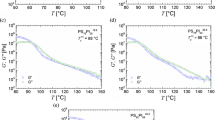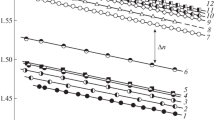Summary
For the system tert-butyl acetate/polystyrene (M= 670000) the phase separation behaviour (upper critical solution temperatures, upper critical solution pressures) is investigated by means of visual and turbidimetric cloud-point measurements and by viscometry. For near-critical concentrations the visually determined cloud-points are found at higher, for low concentrations at lower temperatures as compared with the turbidimetrically determined binodal temperature,T bin Plots of the invers of the turbidity measured atT bin as a function of the polymer concentration,w 2 , yield a minimum from which the critical composition can be determined. The viscometrically obtained demixing points (break-down of the viscosity at normal and at elevated pressures) show that the polymer solutions are stabilized at moderate concentrations. Irrespective of the preselected temperatures and of the present shear-rates (90-640 s−1, the demixing pressures are reduced by almost 20 bar. At sufficiently dilute or concentrated solutions the viscometric demixing points approach the binodal points. The above influences of the shear-field are explained by the rupture of intermolecular segment/segment contacts, which will be most efficient in the neighbourhood of the critical concentration for the formation of entanglements. In the case of the homogeneous solutions, the viscosity coefficientn increases in a fairly exponential manner by a factor of 3-4 per 1000 bar within the range ofp,T,w 2 and shear-rate under investigation (1–1000 bar, -25 to f20 °C, 4–10 wt-% and 25–640 s−1). In plots of logn or ofV* (volume of activation) vs. concentration, extra effects show up when the critical conditions are approached; they result in a “hump” in logn vs.wn2 and in a minimum in V* vs.w 2 .
Zusammenfassung
Für das System tert-Butylacetat/Polystyrol (M = 670000) wird die Phasentrennung (obere kritische Entmischungstemperatur, oberer kritischer Entmischungsdruck) mit Hilfe von visuellen und turbidimetrischen Trübungsmessungen sowie Viskositätsmessungen untersucht. Im Vergleich zur turbidimetrisch bestimmten Binodaltemperatur,T bin , liegen die visuell bestimmten Trübungstemperaturen für annähernd kritische Konzentrationen bei höheten, für niedrige Konzentrationen bei niedrigeren Werten. Auftragungen der reziproken Turbidität bei Tbin als Funktion der Polymerkonzentration,w 2 , zeigen ein Minimum, aus dem die kritische Konzentration bestimmt werden kann. Die viskosimetrisch erhaltenen Entmischungspunkte (Zusammenbruch der Viskosität bei Normaldruck und bei erhöhtem Druck) zeigen, daß die Polymerlösungen bei mittleren Konzentrationen stabilisiert werden. Unabhängig Von Temperatur und Schergefälle (90-640 s−1) liegen die Entmischungsdrücke um ca. 20 bar tiefer. Bei verdünnten oder konzentrierten Lösungen verringert sich die Differenz zwischen viskosimetrischen Entmischungspunkten und Binodalpunkten. Die Einflüsse des Schergefälles werden durch das Zerreißen von intermolekularen Segment/Segment-Kontakten erklärt. Dieser Effekt des Zerreißens von Kontakten ist besonders ausgeprägt in dem Konzentrationsbereich, in dem die Moleküle beginnen sich zu übetlappen. Im untersuchtenp,T,ω2 und Schergef←lebereich (1 – 1000 bar, -25 bis +20°C, 4–10 Gew.% und 25–640 s−1) nimmt die Viskosität der homogenen Lösungen annähernd exponentiell um einen Faktor 3-4 pro 1000 bar zu. In Auftragungen von log ν oder von V+ (Fließaktivierungsvolumen) gegen die Konzentration treten bei Annäherung an die kritischen Bedingungen Zusatzeffekte auf, die zu einem „Buckel” in den log ν (ω2)-Kurven und zu einem Minimum in V* (ω2) führen.
Similar content being viewed by others
References
Wolf, B. A., R. Jend, Macromolecules12, 732 (1979).
Schuch, W., Diplomarbeit (Mainz 1977).
Wolf, B. A., G. Blaum, Macromolecules9, 579 (1976).
Koningsveld, R., A. J. Staverman, J. Pol. Sci. A-2,6, 325 (1968).
Debye, P., B. Chu, D. Woermann, J. Chem. Phys.36, 851 (1962).
Chu, B., F. J. Schoenes, M. E. Fischer, Plays. Rev.185, 219 (1969).
Kuwahara, N., D. F. Fenby, M. Tamsky, B. Chu, J. Chem. Phys.55, 1140 (1971).
Scholte, Th. G., J. Pol. Sci., A-2,9, 1553 (1971).
Derham, K. W., J. Goldsbrough, M. Gordon, Pure Applied Chem.38, 97 (1974).
Rehage, G., D. Möller, O. Ernst, Makromol. Chem.88, 232 (1965).
Koningsveld, R., A. J. Staverman, J. Pol. Sci.C-16, 1775 (1967).
Saeki, S., N. Kuwahara, M. Kaneko, Macromolecules9, 101 (1976).
Strate, G. V., W. Philipoff, Polym. Letters12, 267 (1974).
Schmidt, J. R. (unpublished results).
Springer, J., W. Rüdiger, Colloid Pol. Sci.256, 526 (1978).
Wolf, B. A., M. C. Sezen, Macromolecules10, 1010 (1977).
Bondi, A., Ann. N. Y. Acad. Sci.53, 870 (1951).
Kadzaharov, V. T., Izv. Vyssh. Uchebn. Zaved; Neft Gaz 20, 1, 88 (1977).
Rigler, J. K., B. A. Wolf, J. W. Breitenbach, Angew. Makrom. Chem.57, 15 (1977).
Ward, A. G., Trans. Faraday Soc.33, 88 (1937);E. N. Andrade, Phil. Mag.17, 497, 698 (1934).;J. de Guzman, Soc. Esp. Fisica y Quimica11, 353 (1913);H. Eyring, J. Chem. Phys.4, 283 (1936);H. Eyring et al., ibid.5, 726 896 (1937).
Debye, P., B. Chu, D. Woermann, J. Pol.. Sci.A 1, 249 (1963).
Author information
Authors and Affiliations
Rights and permissions
About this article
Cite this article
Schmidt, J.R., Wolf, B.A. Demixing of unsheared and sheared solutions of polystyrene in tert-butylacetate and the pressure influence on their flow behaviour. Colloid & Polymer Sci 257, 1188–1195 (1979). https://doi.org/10.1007/BF01517243
Received:
Issue Date:
DOI: https://doi.org/10.1007/BF01517243




